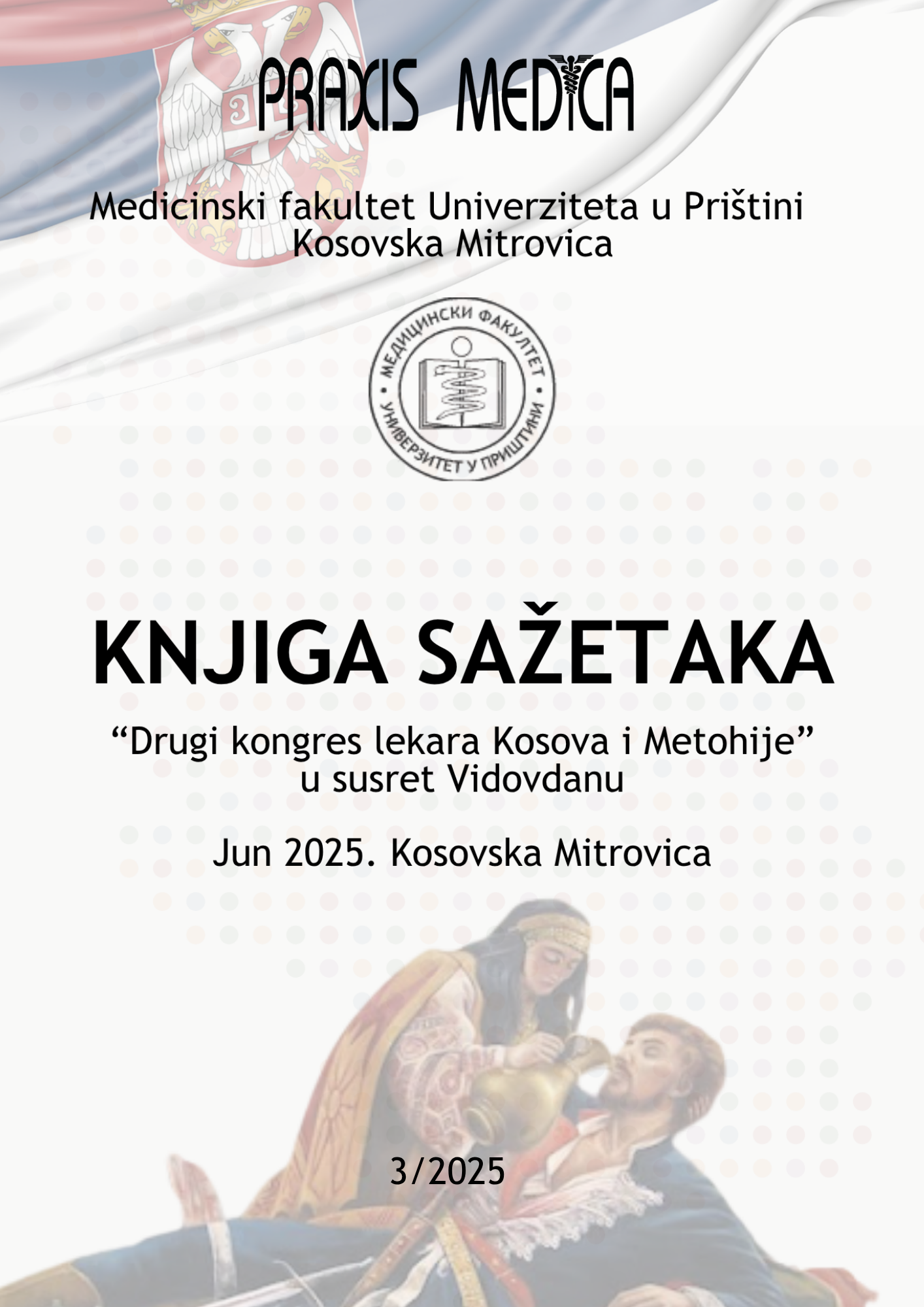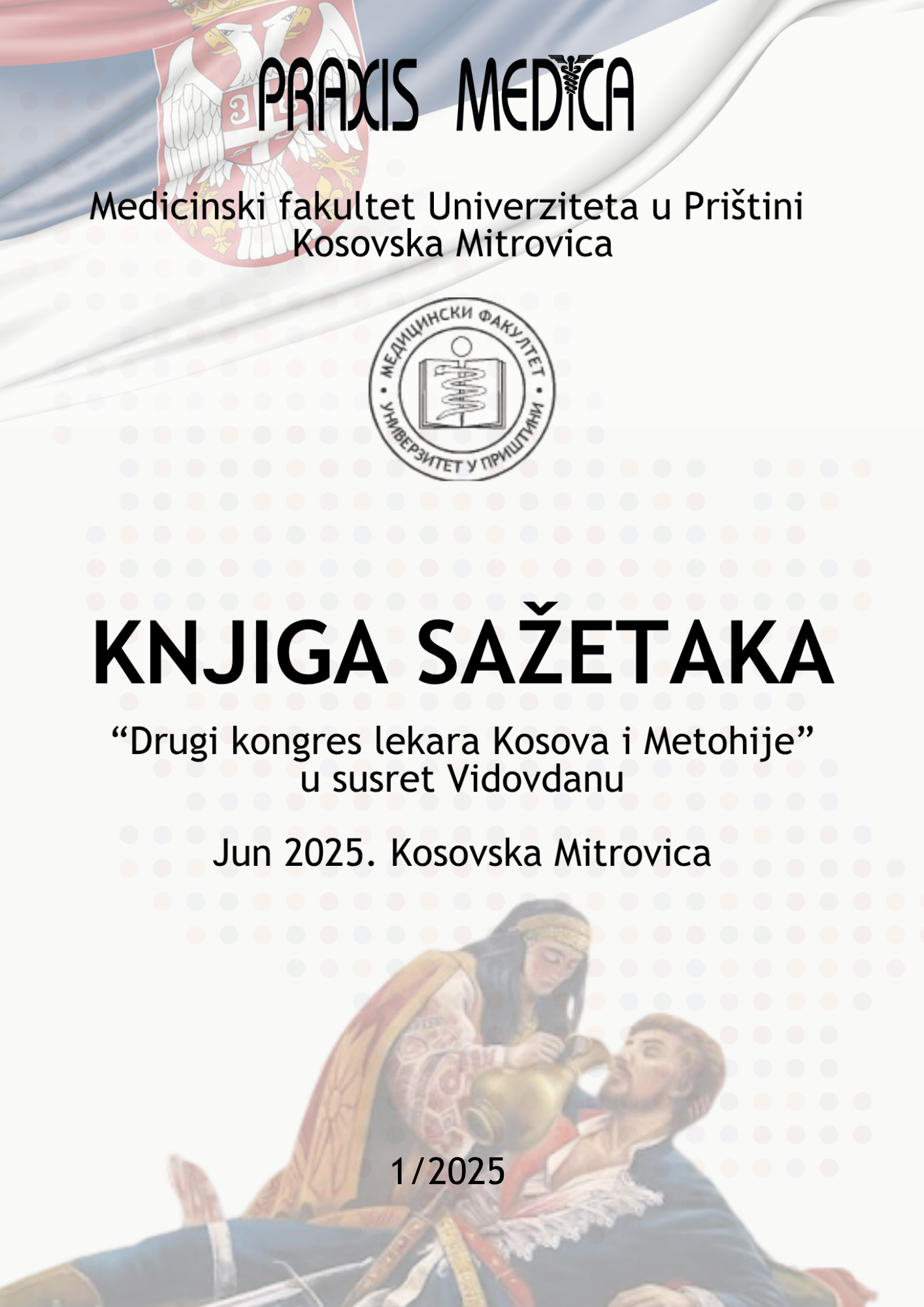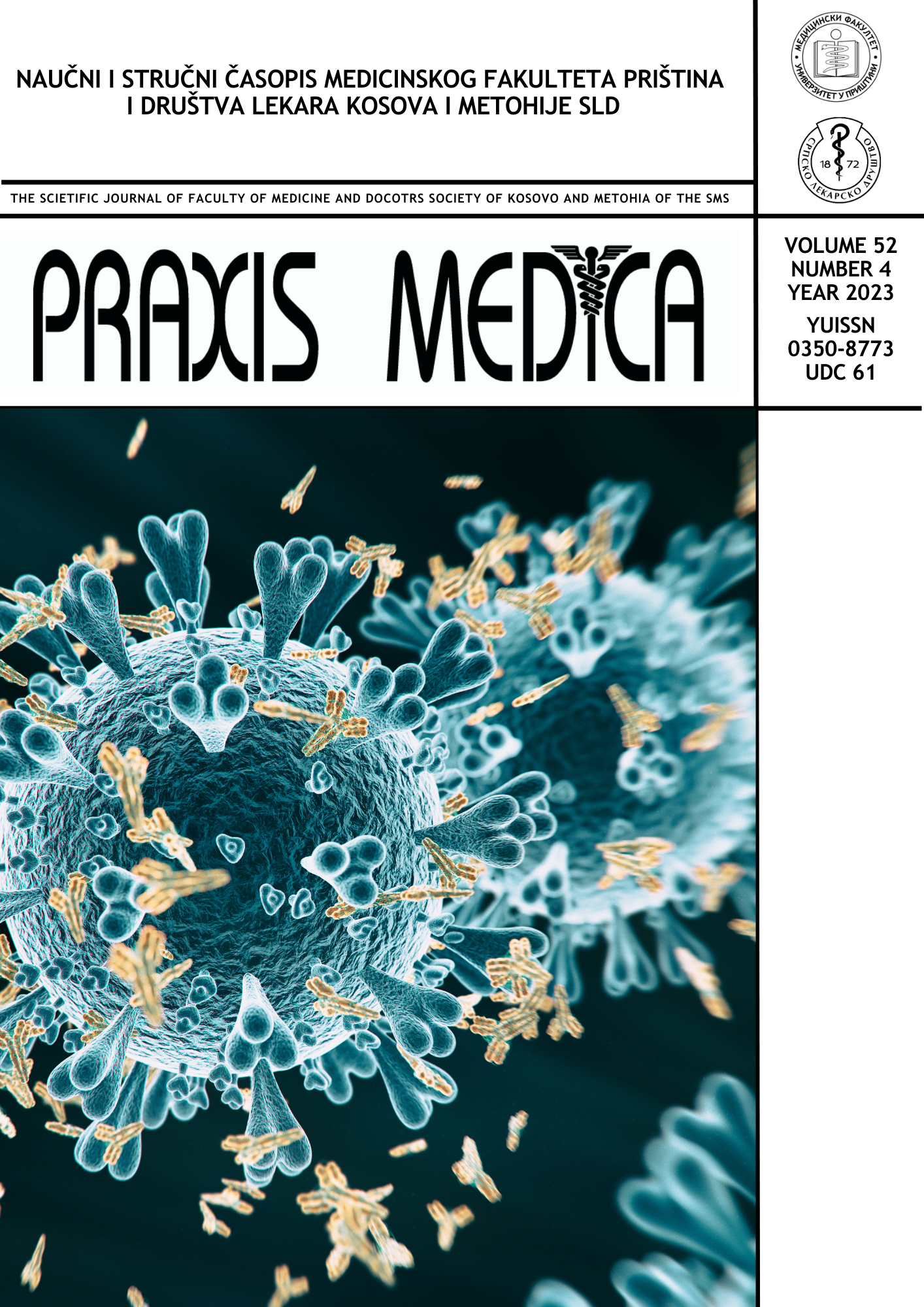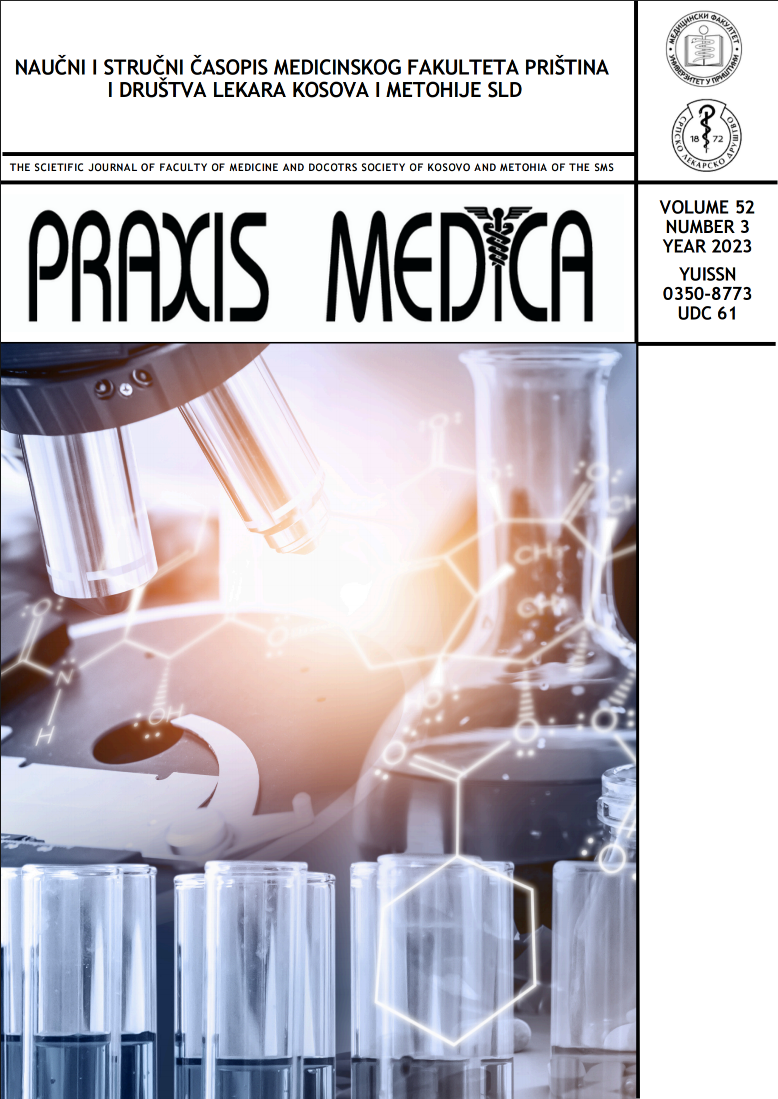Current issue

Volume 53, Issue 4, 2025
Online ISSN: 2560-3310
ISSN: 0350-8773
Volume 53 , Issue 4, (2025)
Published: 30.06.2025.
Open Access
All issues
Contents
01.01.2003.
Professional paper
CONTRIBUTION OF THE URGENT SURGERY CENTER "SIMONIDA" IN CUREING POPULATION OF SERBIAN ENCLAVES IN KOSOVO AND METOHIA
The urgent surgery center “Simonida” in Gra~anica was built by humanitarian organization “Doctors of the World” from Greece with donation of Ministry of Foreign affairs of Greece and Greek institute for mother and child. He started working in march 2000. Even though, it has a small capacity of 15 beds, it represent a very important part in health care for the people Serbian enclaves in Kosovo and Metohia. During 2002. 15133 patients were examined in this hospitaly. 811 patient were hospitalized, and 98 of them were operated. Serbian doctors performed the firs surgery 11.07.2002. when the patient S.S. 46 years old was operated due to inguinal hernia on left side. In the urgent surgery center 72 (73,47%) male patients and 26 (26,53%) female patients. Were operated 64 (65,31%) adults patients and 34 (34,69%) children were operated. In this hospital 46 patients for inguinal hernia, 14 patients for acuta appendicitis, 8 for inflammation of gall, 4 for testis retency, 4 for pilonoidal sinus, 3 for higrom, and 22 patients with other diseased were operated. Total anestesy used with 68 (69,63%), spinalis with 22 (22,45%) and local with 8 (8,16%) patients. Total anestesy was used with 36 adulta patients and with 32 children patients. Considering the restricted freedom of moveing and bad security situation of people in enclaves, the urgent surgery center “Simonida” justify its egzistence making possible adequate surgery help to the suftering peoples of Central Kosovo, Sirini} region and region Kosovsko Pomoravlje.
J. Mladenović, N. Videnović, D. Perić
01.01.2003.
Reports
THE LEVEL OF KNOWLEDGE OF STUDIES OF MEDICAL FACULTY PRIŠTINA ABOUT NOSOCOMIAL INFECTIOUS
Nosocomial infectious (NI) are very big problem nowdays. The aim of this was to investigate the level of knowledge of medicial students of University Pristina about NI and to compare the knowledge level of preclinical with knowledge level of clinical students about NI. Cross-sectional study was conducte in May 2001. The instrument of survey was questionnaire with 28 questions wich were distributed to all third-year (preclinical) students and to all fifth-year (clinical) students and to all fifth-year (clinical) students at the Medical Faculty Pristina. The majority of third-year students (78,2%) and fifth-year students (91,1%) knew the definition of NI and their reservoirs (100.0%). The fifth-year students gave correct answers, statisticaly significant, more frequently (X} =4.62; df=1, p<0.05). The majority of students (89,1% of third-year and 96,4% of fifth-year students) knew that NI could be prevented, but only 14,5% of third-year and 25% of fifth-year students considered handwashing the basic measure for prevention, although there is no statisticaly significant difference between third-year students (X' =2.62; df=1, p>0.05). Around 98% students percepted the risk of NI for medical staff. Around 80% of students estimated that the aditional lectures about NI are needed during the studies. The fifth-year students more frequently showed higher level of knowledge about multidrug-resistant bacteria (X* =17.77; df=1, p<0.01).
Approximately 70% of third-year students gained knowledge about NI from sources other than lectures, but 75% of fifth-year students gained that knowledge from lectures in epydemiology. Additional information about NI, especially about univesal precution, is needen for medical students. Tt is very important to appropriately organise the studies with more practical work in prevention of NI. The emphasise should be put on health edecation in order to increase knowledge about NI, general hygienic measures encouraging handwashing and correct use proper dezinfectans in order to control the hospital environment.
S. Samardzić, T. Simović, Z. Džordžević, Lj. Denić
01.01.2003.
Science Reports
SOMETHING MORE ABOUT CANCER
Until sixties of twenty centuries, it was little now abaot cancer. It was well-know than chemicals , radiation, onko viruses, can to provoke cancer.Untill seventies it was clear than cancer is not infection or inborn sicness.Than eighties discovering onko-gens (gens normal indebted for growth of cell who is mute. Understad is than cancer cell could be continue growth, and they must have onko gen ON and cancer supresor OFF. Discover so and fenomena of apoptosissuicide cell what something wrong begin.For the time of nineties thay are discover reasons of apoptosis. The main one is TP53 gen on short part of hromosoma 17, with 1179 letter. It's understand than cancer begining with muting gens what is reason of growth, continuing with muting gens what suprim growing and finish with fold of last defence muting gen TP53.In therapy of cancer is searcing for agenc who will stimulate apoptosis.Big step what genetics do on understanding cancer give us reall chance to beat cancer.
J. Živković
01.01.2003.
Case Reports
TUBAL GRAVIDITY
A 23-year-old primigravida in 7 weeks of pregnancy with tubal pregnancy. Clinical and ultrasound examinations indicated ectopic pregnancy; emergency laparatomy was performed. Intraoperatively, the tuabal pregnancy with a ruptured hole was revealed. Typical salpingectomy was carried out. Hystology confirmed tubal pregnancy. The postope-rative cours was normal.
B. Petrović, Lj. Ristić, G. Relić, N. Stanišić, N. Milinić
01.01.2003.
Case Reports
FULMINANT HEPATITIS E - a case report
Fulminant form of acute viral hepatitis E in adult patiens, except pregnants women, is very rare. The authors describe a 50 year-old man with diagnosis of viral hepatitis E on basis of antibodies found in IgM class to hepatitis E virus using ELISAtechnique. The disease had a fulminant course wich ended in death.
D. Milošev-Žilović, M. Marković, J. Maksin
01.01.2003.
Professional paper
FEBRILE NON-HEMOLITIC TRANSFUSION REACTION
Febrile non-hemolytic transfusion reaction (FNHTR) is the most common adverse effect of blood transfusion. FNHTR is usually immune mediated due to the reaction of white cells antibodies in the recipient's plasma with the leukocytes contanied in the transfused blood components. In some patients, especially recipients transfused with platelets, cytokines are implicated in this reaction. The differential diagnosis may be difficult, especially when co-morbid disorders such as infection or malignancy, and certain treatments, may cause a similar spectrum of symptoms. In differential diagnosis, acute haemolytic transfusion reaction, bacterialy contaminated blood products and transfusion associated lung injury must be exlcuded. Repeated severe FNHTRs necessitate leucocyte depletion of blood components.
N. Vučelić, N. Savić
01.01.2003.
Professional paper
ACTIVITIES OF THE HEALTH CENTER ZUBIN POTOK IN HEALTH PROTECTION OF THE POPULATION FROM 1999-2000.
Certainly the level of the health protection of the population is in a direct connection with the living standard of people. Life and work of all the people in Zubin Potok municipality, as well giving the health help, became more difficult after 1999. It is because of the exile of non-Albanian population from teritory of Kosovo and Metohia. The most difficult problem, taking care of sick people, results from the impossibility of the normal traffic communication with Priština and Kosovska Mitrovica, where the Main Health Centers are located. More over, the irregular supplying with medicines, difficult transportation of patients, as well the downsizing of mean in this area, made the workers of Health center in Zubin Potok to make some changes in order to provide an adequate health protection for more than 10000 people in this area.
B. Jakšiċ, L. Radosavljević, Lj. Baščarević, Lj. Božović, J. Radić
01.01.2002.
Original scientific paper
CHRONOTIPOLOGY IN PLANNING DAILY ACTIVITIES
Planning daily activities, depending on neurophysiological chronotipology, is one of the steps, which should be taken towards the more successful, healthier, high quality life. Aperiod of time within a day during which the individuals of both sexes, different age and profession are intellectually the most optimally efficient, was determined in the paper. The chronotype of a given person was taken into account for that purpose. The research was carried out using a questionnaire. The questioned individuals were divided into four groups: 120 students at the University of Novi Sad, 50 professors at the University of Novi Sad, 50 railway workers and 50 female civil servants employed in administration. The obtained results show the following: the highest percentages of students belong to the morning chronotype. They sleep more than professors do and the optimal time convenient for mental and heavy physical work is from 11 AM to 1 PM. This data should be taken into account while planning student tests. The University professors, both male and female, belong to the morning chronotype. The female professors sleep more than male professors, but are psychologically and physically optimally productive at the same time as the male professors, from 8 AM till 10 AM. In the group of railway workers, the most common are individuals of indifferent chronotype. The highest percentage of women employed in administration belong to the morning chronotype and for their optimal psychological activity they choose the period of time between 8 and 10 AM, as well as the railway workers. According to the opinion of most people that have been questioned, among all of the abovementioned groups, the optimal five-hour working period should begin at 8.30 AM.
V. Ivetić, M. Hodolič, Z. Milanović
01.01.2002.
Original scientific paper
ACTIVATES OF GLUTATION PEROXIDASE, GLUTATHION AND GLUTATION REDUCTASE IN HEALTHY AND DIABETES (INSULINE DEPENDENT) PATIENTS
Reduced glutathion (GSH), glutathion-reductase (GR) and glutathion-peroxidase (GSH-Px) are significant indicators of oxidative stress. Oxidative stress is a consequence of increased production of reactive oxygen radicals and/or on the other hand, insufficient antioxidative protection. It is well-known that free radicals have key role in the large number of biological phenomena, such as differentiation, transformation, signal transduction, aging etc., and they are important factors in pathogenesis of various diseases (carcinoma, diabetes, Alzheimer, Parkinson, aterosclerosis). This paper presents results of investigation of content of GSH and activities of GR and GSH-Px in healthy patients and diabetes insulindependent patients between 20 and 75 years of age in the region of Indjija. Correlation between investigated parameters in healthy persons and diabetics was found, as well as with results of similar investigations in other countries. Investigated sample comprised 200 healthy patients (20-75 years) divided into 5 groups, and 80 diabetes patients divided into 4 groups. Every group consisted of equal number of males and females. Above mentioned parameters were determined in hemolysate. Parameters change depending on patient age, and changes are more intense in all patients. Some differences exist in correlation of our results with results obtained in other regions.
А. Kozić, М. Popović, V. Ivetić, V. Pilija
01.01.2002.
Original scientific paper
SKIN ALERGIC "PRICK" TEST IN THE DIAGNOSIS OF THE RHINOSINUSAL DISEASES
Aim of this work was to ascertain kind and frequency of skin sensibility to inhalation allergens and determine importance of skin allergic "prick" test. Investigation was accomplished on 141 patients by skin allergic test in vivo with standard "prick" technique. The results of work have showed that allergy is unquestionably present in the rhinosinusal diseases, as well as certain relationship between these diseases and allergic skin "prick" test, but this relationship was insufficient to determine skin allergic "prick" test as enough sensitive and specific diagnostic method for diagnose allergic rhinosinusal diseases. "Positive" allergic skin "prick" test demonstrate patient's hypersensitive reponse on inhalation allergens and existence of allergy, but not the direct connection between this hypersensitive reaction and rhinosinusal diseases. "Negative" allergic skin "prick" test not exclude existence of allergy, and for that, patients which have suspect allergy at the aim of further investigation must be apply other more sensitive and specific diagnostic method.
B. Belić, R. Andrić











